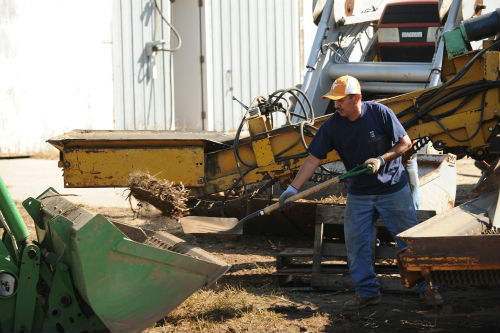
Sands of Time
In the Central Sands region of Wisconsin, made famous in Aldo Leopold’s book, A Sand County Almanac,” Steve Diercks, 67, and his son Andy Diercks, 45, were busy bringing in the 2014 fall harvest when I showed up on a late afternoon in September at their farm.
Here on the outskirts of the village of Coloma, population 450, (according to the 2010 U.S. census), the Diercks family has been growing potatoes since 1961.
Steve’s father, Robert, and his grandfather, Benjamin, first started growing seed potatoes in Langlade County, near Antigo, roughly 90 miles due north of Coloma, in the 1930s.
“They came down here in ’61 because it’s 30 days earlier than Langlade County for harvest,” Steve said of the origin of the Coloma farm.
They split the farms in 1970 with Steve and his father taking the Coloma farm and Robert’s brothers taking the Antigo farm.
These days Steve and Andy oversee an operation of 2,700 acres with 800 acres planted in potatoes for the chip, fries and fresh markets.

“Our largest portion is in frozen processing with McCain’s,” Steve said. “A third is chip, off the field. We don’t store any, we ship directly off the field.”
The Diercks’ grow Silvertons, Gold Rush, Atlantics, Burbanks, some yellows, reds and round whites. They’re on a three- to four-year rotation. Depending on the market, they’ll grow field corn, sweet corn, snap beans, peas and soybeans in rotation.
“We also lease some ground to some vegetable canners and do some custom farming for them,” Steve said.
Father and son work together, with each taking on specific chores while sharing the physical labors. There’s a transition plan slowly evolving with Andy taking on more responsibilities and Steve picking and choosing the work he wants to continue doing.
“Andy’s doing more and more stuff. The stuff I don’t like, I give to him,” Steve said. “I like to grow things. I like irrigating. I like to grow crops.”
Andy takes care of the bureaucratic filings, Food Safety Modernization Act and Good Agricultural Practices paperwork and moving the crop to market.
He recently oversaw the construction of a new packing shed in 2012.
“Our old one wasn’t going to pass any safety inspection,” Andy said. “It’s got a septic tank in the middle of the floor. It’s an old wood building. It’s probably 35 years old. Either you stop doing it or you upgrade.”

He said there are not a lot of packing sheds in the area so the new shed gives them an opportunity to take in potatoes from growers who don’t have packing facilities.
“We’re on the south end of the sands so sometimes we can get in a few days earlier on some of the early reds and whites,” he said. “It helps us maintain our diversity between fresh markets, chips and all that stuff.”
The Diercks’ have their own brand, “Land-O-Lakes,” but they’re not trying to build up their brand. Instead they pack their potatoes for local shippers.
“We do our own packing and shipping but we really don’t do our own marketing,” Steve said. “Alsums, Bushmans and the Wysockis, those guys generally do our marketing.”
Andy said that it’s hard to market to the bigger chains because they demand a 365-day supply and the Diercks’ can’t meet that demand.
When it comes to specialty varieties, they’re willing to try most anything, at least once.
“We’ve grown some small purples and reds, over the years. We haven’t grown fingerlings, yet, but I guess we’ll try them all,” Steve said.
“We’re always looking for opportunities,” Andy said. “We tried a local co-op called Wisconsin Food Hub. It’s trying to market a variety of Wisconsin products locally here in Wisconsin, Chicago, maybe in Indianapolis. That’s one way we’ve tried to work more directly with the customers.”
Planting begins around the first week of April and is finished by the first weekend of May, weather permitting. Average annual rainfall in the area is 33 inches, with a growing season of 135 days.
“It takes about three weeks to get the crop in, depending on when we start,” Steve said. “The later you start, the harder you push, the earlier you start you don’t push quite as hard.”
Andy said harvesting of quick stock and early fresh varieties begins the last week of July or the first week of August and is usually finished the first week of October.
They consistently experience disease pressure from early blight and late blight and average 14 fungicide applications each growing season to control disease.
“Colorado potato beetles are, by far, our biggest insect problem,” Steve said. “If we lose neonics, or don’t use them, leafhoppers and aphids might become more of a problem.”
The Diercks’ attribute part of their success to the long-term relationship they’ve enjoyed with the University of Wisconsin Extension and research communities.
“We think we have the best potato research team in North America, probably the only complete one, anymore,” Andy said. “Our farm has had a great association with the university for 50 or 60 years. That’s a big part of our effort and our education and it works in both directions. Those guys have learned a lot from the growers and the growers have learned a lot from them. It’s one of the things that compelled me to stay here.”
Both Steve and Andy have been actively involved in state and national potato organizations. Steve has pulled back a little and given Andy the reins when it comes to sitting in hearings and on committees.
“Somebody has to do it. Somebody has to be involved,” Andy said. “We probably had 300 potato farms 25 to 30 years ago. Now we’re down to less than 100. We like to be progressive rather than reactive. That’s a philosophy we’ve always followed, with the university, with the legislature, with the national organizations and with local, for that matter.”

















